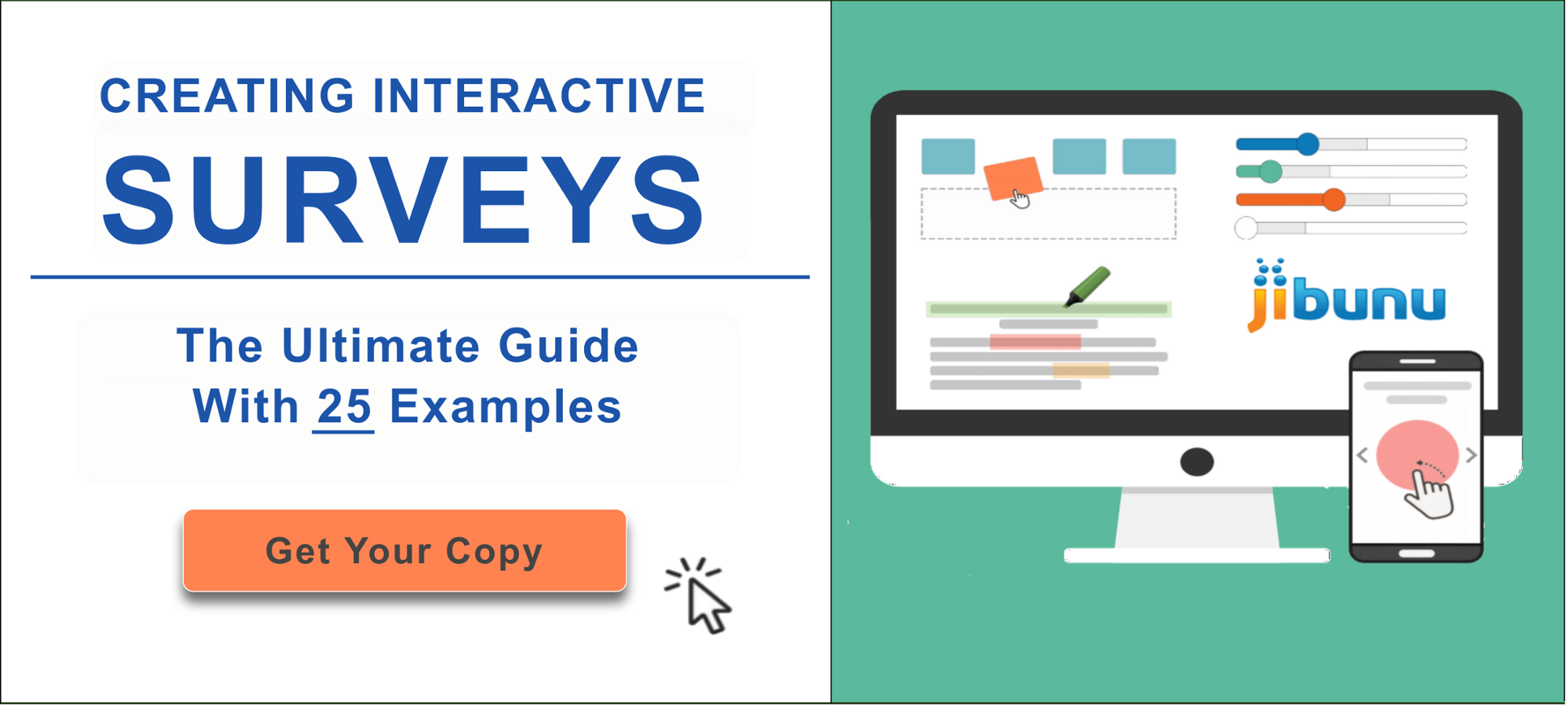Over the years, surveys have undergone a number of developments and evolutions in order to better adapt to changing technologies and industries. But surveys have yet to decrease in value or importance, and that isn’t likely to change anytime soon. However, if you want your surveys to really stand out and engage your respondents, you’re going to need to go the extra mile in your survey design.
One of the most effective features you can add to a survey is interactivity. According to Content Marketing Institute, interactive content is on the rise online. The number one reason why interactivity is being used (75% of respondents surveyed) is for the purpose of educating the audience. Interactive surveys are just one of the many tools researchers have embraced in order to improve a respondent’s survey experience, enhance the quality of their answers, and help surveys feel more engaging and dynamic than they ever have before.
If you’re wondering if an interactive survey design is right for you, the short answer is “yes, yes they are.” If you’re looking for more than that, however, then keep reading so we can help equip you with a comprehensive overview of what makes a survey interactive, what makes interactive surveys uniquely valuable to researchers, and ultimately, how you can embrace them yourself.
Table of Contents:
What Makes a Survey Interactive?
Getting Started with Some Best Practices
- Define Goals
- Prioritize Simplicity
- Strategic Use of Interactive Tools
- Question Grouping
- Testing and Mobile Optimization
What Makes a Survey Interactive?

An interactive survey, like all surveys, is designed to gather valuable data from a group of respondents. What makes interactive surveys unique is, you guessed it, their interactivity! Where a traditional survey consists of a list of questions, an interactive survey involves questions that use a variety of tools that diversify the respondent’s experience by allowing them to answer questions in new and clever ways.
Online survey interaction takes advantage of at least 3 of the 5 senses – sight, sound, and touch. Here are just a few of the common interactive options, and accompanying examples, that you’re likely to find in interactive surveys:
 While these are some of the interactive staples surveys rely on, the options don’t stop there. Part of the appeal of interactive surveys is their incredible versatility, and each individual company can design a survey that mixes-and-matches the features from above or even do something entirely different, such as gamification, build-your-own exercises, or themed quizzes.
While these are some of the interactive staples surveys rely on, the options don’t stop there. Part of the appeal of interactive surveys is their incredible versatility, and each individual company can design a survey that mixes-and-matches the features from above or even do something entirely different, such as gamification, build-your-own exercises, or themed quizzes.


Okay, so now that you know what makes an interactive survey unique, it’s time to talk about why interactive surveys are a valuable and intuitive tool that you should be making use of in all of your survey efforts.
Why Use Interactive Tools?
Ultimately, the goal of an interactive survey remains unchanged from the goal of a traditional survey. Researchers want to gather the most honest and valuable answers they can get from their respondents, and interactivity is just one of the many tools they can use to achieve that goal. If your audience takes a lot of surveys, for example, then they may be familiar with “survey fatigue” and appreciate an experience that’s more dynamic than a monotonous list of questions and answers.
Surveys remain as important as ever, but it’s possible that the audience you’re going after view surveys as outdated or inconvenient. For example, in early 2018, the GRIT Report—one of the leading market research publications—surveyed approximately 4,000 researchers in order to measure the industry’s sentiment toward their data collection, and then use that information to try and predict any future trends. The results of this study showed that:
“39% of surveyed researchers expected the quality of their respondent’s feedback to decline over the next three years.”
This is unfortunate because there are plenty of developments in the survey world that can help researchers not only keep their respondent’s answers consistent but more importantly improve upon them as well. With the right interactivity, the right design, and the right questions, researchers can improve the quality of their respondent’s answers, maximize completion rates, and ultimately build a better audience of respondents eager to take more surveys in the future.
Is Interactive Right For You?
As useful as interactive surveys are, they’re still a semi-new development in the data collection world, and as such, have yet to be fully embraced by the market research community. Interactive options also require more time, effort, and investment in order to be created and properly implemented. So if you decide that interactivity is right for you, you’re going to want to be sure.
Luckily, interactive surveys are well-equipped with a variety of benefits that make them easy to invest in. For starters, where a traditional survey can become an exhausting wall of text, an interactive survey can take that same text and information and transform it into a visually exciting and intuitive experience that’ll help hold your respondent’s attention for longer. And the longer you hold your respondent’s attention, the better the respondent’s experience will be and the better your research quality will be.
By utilizing interactivity in your surveys, you’ll not only be promoting a more enjoyable respondent experience but you’ll also be differentiating yourself from the competition. There are a countless number of outlets all vying for a respondent’s attention, but the odds are that there are very few of them who can provide the kind of interactive experience you and your surveys can.

Ultimately, the more specialized your surveys are, the better you’ll be able to stand out from the crowd. People place a lot of value in convenience and originality, and interactive surveys can be a powerful tool in helping you provide your customers with exactly that.
Getting Started with Some Best Practices

If you’ve decided to look into how interactive surveys can help you, then congratulations! You’ve just taken your first step toward an exciting new world of survey-taking. However, before you get started on the brainstorming and design process of your survey, you’ll want to make sure the foundational principles of your survey are solid.
This means refining your data collection process, ensuring that you’re asking the right kinds of questions to the right kinds of people, doubling down on the privacy and confidentiality of your survey results so respondents feel safe trusting you with their information, and ultimately, deciding whether interactivity is the right route for you to go down in your survey methodology.
Your survey should be like a conversation between you and your respondent, and any good conversation needs to be—you guessed it!—conversational. If your survey reads like a textbook or a scholarly thesis paper, you’re going to scare your respondents away.
To help you pinpoint what makes an interactive survey distinct from the traditional surveys you and your respondents may be used to, and to show you how to make an interactive survey of your own, here’s a breakdown of the tools, techniques, and interactive survey steps that will help you ditch the outdated models of the past and adopts the exciting new models of today.
Define Goals
When you’re looking to get started, you have to begin by considering what it is that you want your survey to accomplish. It’s important that you understand your goals before reaching the design phase. This way, you can effectively pursue the kind of interactive elements that will work best for your circumstance and avoid the ones that will not.
Your design goals are like the destination waiting for you at the end of a journey. They can help you visualize the end results and fill in the blanks in order to help you get there. Goals alone won’t be enough though. In order to create a survey that’s dynamic and engaging, you may have to brainstorm some ideas and play around with how you use your various forms of media.
Prioritize Simplicity
Like we said above, a survey shouldn’t read like a textbook. Textbooks are packed with dense blocks of text, small font, dizzying white space, and often obtuse language. Surveys, in contrast, should consist of simple, easy-to-read questions that adopt the accessibility of a casual face-to-face conversation.
The more approachable your survey is, the easier it’ll be for your audience to answer your questions and see the survey through to completion. This means keeping your survey at a manageable length as well. Many surveys—even interactive ones—overstay their welcome and end up exhausting their respondents before they’ve reached the end.
It can be challenging to pinpoint what the “perfect” length for a survey is, the irony is that many customers often want to tell you what they think, but “they want to do it in an easy and timely fashion and in a way that works for them and allows them to tell you what matters to them.”
Long, difficult-to-read surveys are surveys that won’t be finished. Meanwhile, compact, precise, and approachable surveys are surveys that won’t only be finished, but may even attract a wider audience of people.
Strategic Use of Interactive Tools

Too much of a good thing is a bad thing. Make sure to use interactivity only where it makes sense in the survey. Choose wisely.
Be careful to not make a question harder to answer just for the sake of adding interactivity. Sure, you could add a drag and drop to answer the question of “How many people in your family? Drag a person into the box for each family member.” Please don’t do this to your respondents. Keep that to a simple number entry question.
Also, consider if the interactive feature is unnecessarily adding time to the length of the survey (LOI). An example of this is page flipping. Designers and clients tend to love page flipping. A respondent might enjoy it for the first-or-second-page flip, but after that, it just becomes slow and annoying. Now you’ve added to your LOI and cost only to irritate the respondent.
If you answer yes to any of the following questions, then consider skipping the interactivity for that question.
- Is it hard to answer?
- Is it requiring more clicks (or other actions) than the traditional question?
- Is it going to slow down the respondent?
- Does the respondent have to read complex rules?
The goal of interactivity is to improvement the respondents experience by making something boring into something fun, but if the interactivity you implement is clunky or prolongs the survey-taking process, then it isn’t doing its job correctly. The ultimate objective of an interactive survey is to create a survey that your respondents should finish, provide good answers for, and ultimately, enjoy—or at least appreciate—the overall experience you’ve given them.
Question Grouping
You’re also going to want to outline your survey’s questions in a way that encourages the most honest responses. Pew Research says that:
“The placement of a question can have a greater impact on the result than the particular choice of words used in the question.”
The wrong order of questions can skew your answers one way or another, and as always, testing your survey over and over again is essential if you want to provide respondents with an experience that is unbiased, safe and secure, and ultimately productive for you, your research, and your respondents.
Testing and Mobile Optimization
Before releasing a survey of any kind, however, you’ll always want to run it through a series of tests. Try taking it yourself and see how well the interactive elements respond to the user. Are your drag-and-drop features smooth, or do they lag? Are your sliders working efficiently? The more questions you can ask and answer, the better off you’ll be.
This rings especially true for mobile-optimization, as it’s not uncommon for interactive surveys to run into technical errors when used on a mobile device. In this case, perform your tests, see how well the survey runs, and if you experience problems, either implement a response or create a plan so the survey can reconfigure itself in a way that’ll allow mobile users to engage with it.
Let’s Do This!

Putting together a survey is an important process that involves careful planning, research, design, testing, and implementation. It’s an investment, to be sure, but the more time you spend in the preparation stages, the higher the quality of experience your respondents will have while taking your finished and optimized survey.
Interactive surveys are some of the most versatile and intuitive survey designs available right now, and the sooner you can embrace the benefits they offer, the sooner you can take advantage of the wealth of data they will provide you with.
If you’re looking for a way to get started on an interactive survey of your own, then Jibunu is here to help! We have been programming surveys for over 15-years and are constantly pushing the boundaries of what’s possible in the medium. Whatever your ideas may be, we want to work with you to turn them into an exciting reality.

